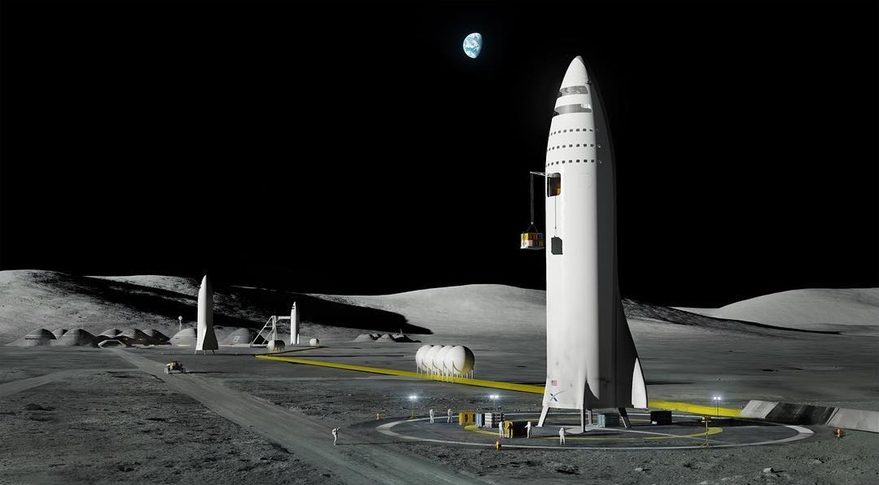
SpaceX’s giant Big Falcon Rocket (BFR) has a sleek new look for an audacious private passenger flight around the moon. If an early rendering is anything to go by, the BFR is going to have some wild fins.
Late last night (Sept. 13), SpaceX announced that it has signed a deal to launch a private passenger flight around the moon with its new BFR megarocket sometime in the future. Details are scant — SpaceX will unveil more on Monday (Sept. 17) during a live webcast — but the private spaceflight company did unveil a new artist’s concept of a BFR passenger rocket around the moon. [The BFR in Images: SpaceX’s Giant Spaceship for Mars & Beyond]
Does that new BFR art look sci-fi? Yes. But is it actually a new version of SpaceX’s BFR? Also, apparently, yes.
SpaceX CEO Elon Musk suggested as much Thursday night. When asked if the SpaceX artist’s rendering was a new version of the BFR, he replied with a straightforward “Yes.”
Taken at face value, the new BFR art suggests SpaceX has made some slight changes to the huge, crewed spaceship.
First, there’s the obvious. Take a look at those awesome fins!
The new rendering shows the BFR spaceship with three large fins, giving it a vaguely shuttle-like profile. There is also a hint of a darker-colored heat shield along its belly, but again, it’s unclear. Both elements would be a departure from earlier designs shown by Musk at International Astronautical Congress meetings in 2016 and 2017. (It was at the 2017 meeting that Musk dubbed the spacecraft the “BFR.” It was called the Interplanetary Transport System before that.) In both of those cases, the BFR had only the slightest hint of two fins, swept far back.
The new rendering shows the BFR crewed spacecraft with seven engines (presumably, SpaceX’s new Raptors) firing as it rounds the moon. Musk’s presentation in 2017 showed a BFR with a total of six Raptor engines, two of which were sea-level engines and the other four reserved for use in the vacuum of space. So, the rendering suggests a new BFR version with seven engines capable of firing in a vacuum.
But what about the booster? The earlier BFR designs shown by Musk in 2016 and 2017 used a massive reusable booster to launch the crewed spaceship into orbit and then return to Earth for later reuse like SpaceX’s Falcon 9 first stages in use today.
In 2016, that BFR booster was gigantic — 40 feet wide (12 meters) — and powered by 42 Raptor engines. By 2017, SpaceX had scaled the booster down a bit. In that new design, the booster was 30 feet (9 m) wide and powered by 31 Raptor engines.
For comparison, the first stage of SpaceX’s workhorse Falcon 9 rocket is 12 feet wide (3.7 m) and powered by nine of the company’s Merlin engines. SpaceX’s heavy-lift Falcon Heavy rocket includes two Falcon 9 first stages around a core booster, each of which uses nine Merlin engines, for a total of 27 engines.
But has the new BFR spaceship’s booster changed since last year? It’s not clear, and we’ll have to wait until Monday to find out.
Just as a refresher, SpaceX’s BFR system (the name can also mean the “Big F—— Rocket”) as laid out by Musk in 2017 was defined as the following:
- It would be a fully reusable, two-stage system that would feature a crewed spacecraft and booster.
- Together, the booster and spacecraft would stand 348 feet (106 m) tall.
- The BFR’s crewed spaceship would stand 157.5 feet (48 m) tall.
- The crewed spaceship would feature 40 cabins and likely carry up to 100 passengers on trips to Mars.
- The crewed spaceship would be capable of supersonic retropropulsion landings much like Falcon 9 rockets today.
- The BFR will be able to launch 150 tons to low Earth orbit, which would make it more powerful than NASA’s Saturn V moon rocket.
- The BFR is designed to foster Mars colonization but could fly point to point around Earth, to the moon and to other parts of the solar system.
- The first uncrewed spaceship tests could begin in 2019, with a potential uncrewed flight to Mars in 2022 and a crewed flight in 2024.
- We’ll have to wait until SpaceX’s big reveal on Monday to find out how much of the BFR design has really changed.
And then there’s the mystery question: Exactly who is SpaceX’s private passenger for the BFR flight around the moon? In February 2017, Musk announced that SpaceX would fly two passengers on a private trip around the moon using its Falcon Heavy rocket and Dragon spacecraft. But earlier this year, Musk said the Falcon Heavy would not fly crewed Dragon flights, with SpaceX shifting instead to its BFR development for deep-space voyages.
Musk has released one tantalizing morsel as a possible clue: Late Thursday, he posted an emoji of a Japanese flag on Twitter in response to a question about who was flying the mission. (The actual tongue-in-cheek question asked if Musk was the passenger. The billionaire did not address it directly.)
So, what do you think about SpaceX’s BFR lunar flight plan? We’ll find out more Monday, when Musk unveils new details in a webcast at 9 p.m. EDT (0100 GMT on Sept. 18).


